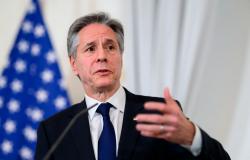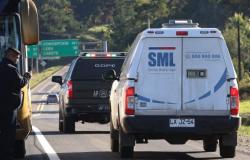
Image source, Two Rivers Media
Peter McAleese was a mercenary who participated in different conflicts such as that of Rhodesia (now Zimbabwe).
- Author, Drafting
- Role, BBC News World*
-
March 28, 2024
In 1989, a team of British mercenaries, led by Scotsman Peter McAleese, traveled to the heart of the criminal empire of the most dangerous man in the world with the aim of assassinating him.
Pablo Escobar was the leader of the Medellín cartel in Colombia and one of the richest criminals in history.
It was the largest manufacturer and distributor of cocaine in the world, then responsible for up to 80% of the global trade in that drug.
McAleese, a former SAS agent – an elite group of the British Army – was hired by a rival drug cartel to eliminate Escobar.
The mercenary died this past March 19 at the age of 81.
In the documentary Killing Escobarwhich premiered in 2021, tells the story of that mission – which ended in failure – and the man behind it.
Image source, Getty Images
Pablo Escobar was one of the richest and most dangerous bosses in the world.
Filmmaker David Whitney said McAleese, who was born in Glasgow in 1942, was a “complex man” who had great “inner restlessness”.
He was raised in the neighborhood of Riddrie in the shadow of Barlinnie Prison, where his father – “a very harsh and violent man” – spent some time.
In the documentary, McAleese said: “I was trained to kill by the Army but the fighting instinct came from Glasgow.”
McAleese claims he left town and joined the Army at age 17 to find a way to channel his aggression.
He enlisted in the Parachute regiment and later became a member of the 22nd SAS regiment.
Image source, Two Rivers Media
McAleese in the South African defense force in the 1980s.
He served in Borneo with the SAS, taking part in a fierce war fought in the jungle, before retiring from the British Army in 1969, a decision he described as the worst thing he has done in his life.
McAleese drifted from job to job “without fitting in.” He said that he felt alone and that his aggression worsened.
The man became so aggressive that Was in jail for attacking a girlfriend.
Upon regaining his freedom, McAleese sought to recreate the “thrill” of his Army career by seeking action as a “mercenary” in the civil war in Angola and later in Rhodesia (present-day Zimbabwe), as well as in South Africa.
He met Dave Tomkins in Angola in 1976. Tomkins was no ordinary soldier, he knew how to make deals to sell weapons.
The two became great friends and it was Tomkims who approached McAleese to offer to participate in the mission to kill Escobar.
Jorge Salcedo, who was part of the Cali poster – a rival drug trafficking group in Colombia – was coordinating the attack and wanted Tomkins to recruit a team to carry it out.
Image source, Two Rivers Media
Identification showing a young Peter McAleese, during his years as a mercenary in Africa in the 1970s.
The training
McAleese was the first person he tried to recruit.
“They don’t ask you to assassinate Pablo Escobar unless you have the required experience,” McAleese said.
“I had no moral conflicts about killing him. I have never considered it as murder. I have seen it as a target,” he said.
The Cali cartel trusted that Escobar he could be murdered when he went to his luxurious Hacienda Nápoles.
The massive estate included an entire zoo filled with exotic animals, a collection of luxury and vintage cars, a private airport, and a bullring.
McAleese flew over the ranch to reconnoitre the place and agreed that it could be carried out. The mission was ambitious.
Tomkins recruited a team of 12 mercenaries. There were people who had worked with him before and people who had been recommended to him.
Jorge Salcedo helped them pass customs controls and the Cali cartel financed their stay.
Each of the men would receive US$5,000 a month plus expenses but Tomkins earned US$1,000 a day.
Image source, Two Rivers Media
Once in Colombia, the mercenaries trained to carry out the attack.
The documentary had access to videos recorded by Tomkins which include scenes in which the men are seen playing with large bales of money.
At first they stayed in the city of Cali but there they ran the risk of attracting too much attention, so they moved to a farm in a rural area where they were given a large arsenal of weapons.
“It was like Christmas. Everything we needed in terms of weapons was there,” McAleese said.
The mercenaries trained hard for their mission but only Tomkins and McAleese knew who their target was.
Before they were informed, one group member decided to leave and was allowed to go home. He sold his story to newspapers but did not reveal names or offer details of the operation.
As the time of the attack approached, the men moved their training to the jungle, where they could practice with guns and bombs without being heard.
Image source, Two Rivers Media
This photo shows the group of mercenaries during training for the assault.
The attack plan
The attack plan involved using two helicopters to transport them to the Hacienda Nápoles complex, where the mercenaries had to shoot their way through Escobar’s large security detail, kill him, and bring back his head as a trophy.
When they were notified by an informant that Escobar was at his ranch, they set out toward their objective. But the attack would never happen.
The helicopter carrying McAleese and Tomkins crashed while flying low in the clouds over the Andes. The pilot was killed.
The others survived but McAleese was too badly injured to leave the scene.
Suffering great pain, he lay on the mountainside for three days until he was rescued.
Escobar heard about the attack plan and sent his men into the mountains to find them.
“If Pablo had caught me, I would have had a long, drawn-out, painful death,” McAleese said.
Instead, he escaped and attempted to fulfill the promises he made to God while lying on the mountainside.
Image source, TWO RIVERS MEDIA
Photo of Peter McAleese at age 78, when he recorded the documentary.
McAleese acknowledged that he was a “dirty, shameless man; trash” and that he realized he had to change.
But he stated that what he regretted was not his actions in the war zones, but his failures as a husband and father.
“I have a horrible amount of regrets and none of them have to do with the soldier part of my life,” he said at 78, as part of the documentary.
At that moment he said he had found “peace.”
Meanwhile, Pablo Escobar was shot dead in Medellín in 1993 while trying to flee from the authorities.
*This information was originally published on March 12, 2021 and was updated following the death of Peter McAleese.
And remember that you can receive notifications. Download the latest version of our app and activate them so you don’t miss our best content.





